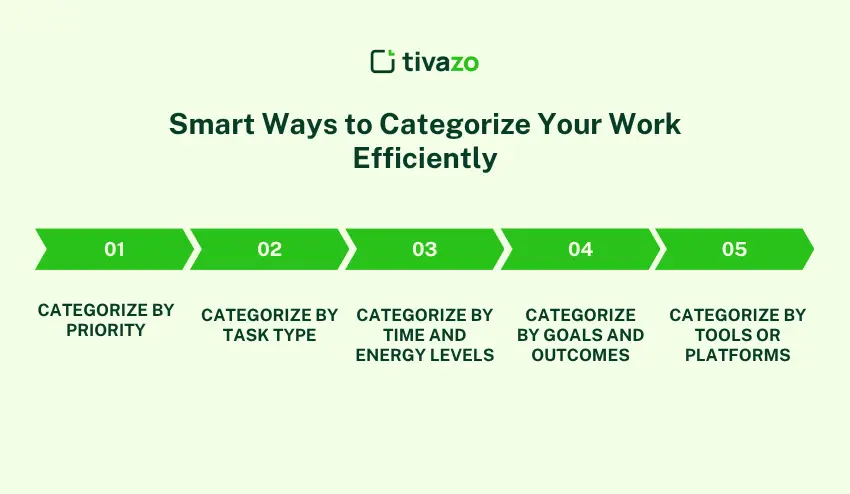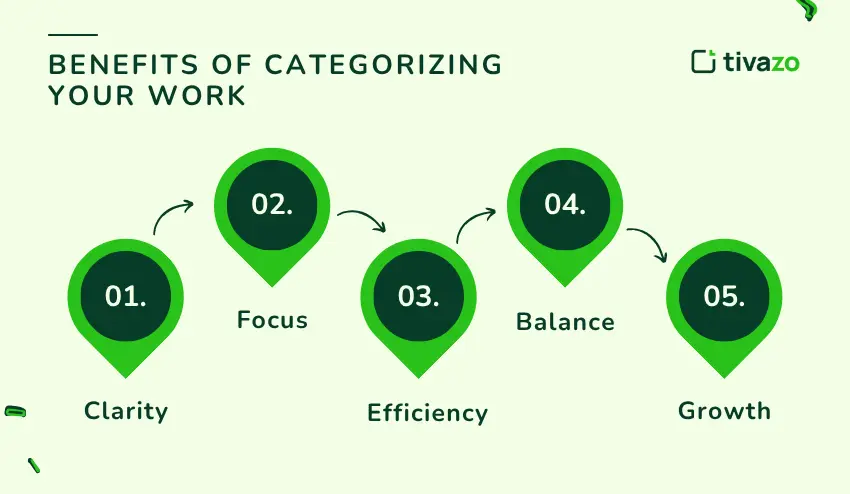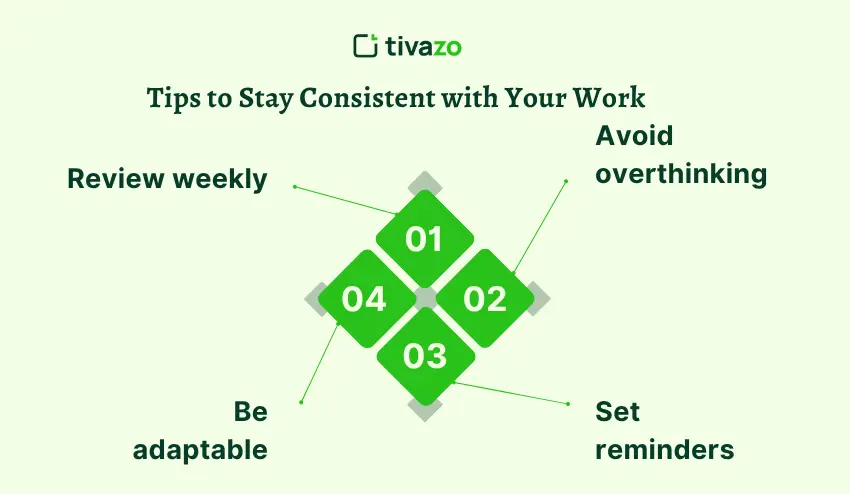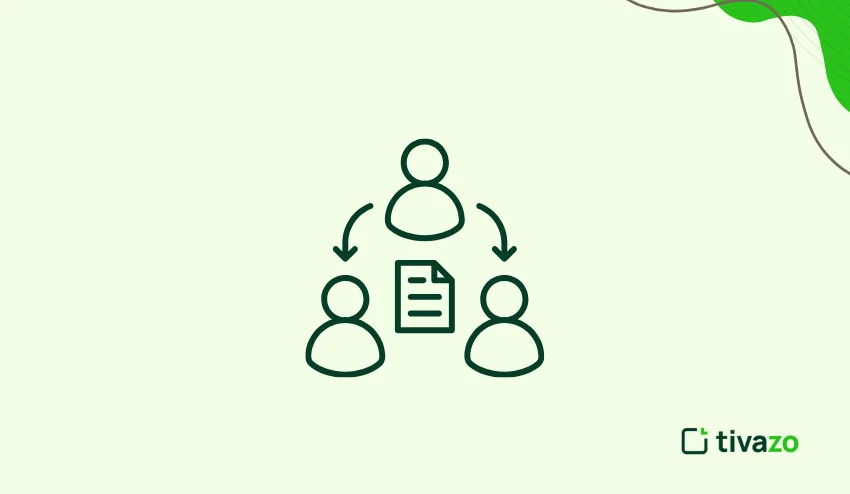Most professionals tackle dozens of tasks each day emails, meetings, reports, projects. If you don’t have a plan to work in an organized manner, these tasks can quickly become overwhelming, consuming both your time and concentration levels. This is when the practice of categorizing your work has the potential to transform your workload for the better.
By placing your tasks into clear categories, you’ll be able to focus in a more directed manner, clear mental clutter, and have greater confidence in what task to direct your attention to first. In this piece, we will examine five of the smartest ways to categorize your work, and how it will enhance your productivity with lower stress and more control.
Key Highlights:
- Why Categorizing Your Work Matters
- Smart Ways to Categorize Your Work Efficiently
- Maintain an Effective Categorization System
- Benefits of Categorizing Your Work
- How Categorization Enhances Team Productivity
Why Categorizing Your Work Matters
Categorizing work is more than just organizing tasks into folders or lists. It helps create a mental and visual roadmap around your responsibilities. Once you start organizing and successfully categorizing your work, you’ll find that your mind has to decide less about what to do next, and spends more time actively doing.
Here’s why it matters:
- Clarity: You’ll know exactly where each task/piece fits best and what to prioritize.
- Focus: Staying together with similar work in a category will give you fewer distractions.
- Energy: Workflow helps you maintain momentum throughout the day.
- Tracking Progress: You’ll be able to see progress in certain areas while determining others that will require more movement and energy.
Simply put, categorizing your work allows your day to have direction not organized chaos.
5 Smart Ways to Categorize Your Work Efficiently
Here are five proven strategies to organize your tasks/projects/priorities to support long-term productivity and focus.

1. Categorize by Priority: Urgent vs. Important
One of the most effective ways to categorize your work is to differentiate between what’s urgent and what’s important. The Eisenhower Matrix is a classic strategy in this respect, dividing tasks into four quadrants:
- Urgent and important → Do it now.
- Important but not urgent → Schedule it.
- Urgent but not important → Delegate it.
- Neither → Delete it.
This technique saves you from falling into the “busyness trap”-being busy and feeling productive while accomplishing very little. More importantly, when you favor important work over work that is merely urgent, you’re able to achieve much more meaningful results and create sustainable growth
2. Categorize by Task Type
Every type of task requires a different type of thinking. Some tasks need creativity, others use logic, and some require just flipping through paper and typing. By clustering by task type, you conserve your mental energy.
For example:
- Creative work: Writing, designing, brainstorming.
- Analytical work: Researching, reviewing data, analysis.
- Administrative work: Emails, calendar scheduling, reporting.
By batching similar tasks, you avoid mental task-switching, a huge productivity killer. You can even combine just giving a block of hours or a whole day to one category of work. It is helpful for your overall workflow and mental energy when you can signpost and batch types of work and avoid mental fatigue.
3. Categorize by Time and Energy Levels
Each hour in your day is never equal some hours of the day leave you feel alert and energized and at other times, it’s hard to muster motivation. The best advice is to classify your work by energy levels.
- High-energy periods: Undertake a complex, strategic piece of work that requires your focus.
- Medium-energy periods: Work on moderate tasks that could include meetings or coordination that doesn’t require deep thought.
- Low-energy periods: Complete repetitive, simple, or administrative tasks.
When you organize your work this way, you are now working with your natural system, not against it. You’ll notice over time how much more productive you are when your periods of energy are matched up against the type of work you are doing.
4. Categorize by Goals and Outcomes
Every piece of work you do should move you closer to an outcome that matters. When you classify by goals, you’re making sure your actions throughout the day are all purposeful.
For example:
- Career growth: Learning new skills, networking, and certifications.
- Company goals: Revenue-related work, client relationships.
- Personal balance: Health, hobbies, rest.
Organizing your work by goals creates a direct link between your daily activities and long-term success. It’s one of the best methods to ensure your work doesn’t just feel like busy work, but purposeful work.
5. Categorize by Tools or Platforms
Most professionals use different tools; they will use email, chat apps, and project management boards while simultaneously tracking time with a tool like Tivazo. Instead of mixing everything together, consider grouping your work based on tools or platforms they could exist in.
For instance:
- Emails → Gmail
- Project management → Asana or ClickUp
- Notes → Notion
- Time tracking → Tivazo
Grouping all similar work in one tool or tool pair avoids confusion. You will have a clear understanding of where to go when executing each type of work maintenance, keeping the workspace organized and the workflow smooth.
How to Maintain an Effective Categorization System
Building a categorization system is the easy part maintaining it is a matter of consistency. Almost every organizational system, even the best, will get cluttered or fall out of date if it’s not looked over regularly. Here’s how to ensure everything is still flowing:
- Review categories weekly and remove anything unnecessary.
Over the life of a project, workflow and categorization may have changed, rendering some category labels redundant. A quick weekly assessment allows you to maintain organization and reduces overlap or confusion with some genres. - Keep your system simple; complexity kills consistency.
The more complex your system is, the harder it will be to stick with it. Clear labels are likely the most effective, and you should avoid creating too many subcategories without being necessary or of great benefit. - Use automation tools where possible.
If there are tools that can help you sort or automate, like rule-based sorting, smart folders, or auto-reminders, that will help provide ongoing sorting of repetitive work that is done manually which can help provide for order without manual effort - Reflect monthly on effectiveness.
Spend a few minutes every month simply asking: Is this still saving me time? If it is not, there may be little tweaks to improve it.
If your system is maintained effectively, it will naturally evolve with your workload and changing priorities, and ensure it remains a tool for clarity instead of clutter.
Common Mistakes When Categorizing Your Work
Some of the best productivity structures can also fall short if you label work the wrong way. Most professionals start strong (making detailed folders, tags, and work lists) only for the process to hit a wall later! The trick here is to not turn your organization into a full-time job. You want your system to work for you, not you for your system.
- Over-classifying: Too many labels or folders can confuse rather than clarify. Make sure your classification is general enough to help, but simple enough to keep you focused.
- Not updating categories: As projects grow, certain categories might fall flat. Committing to updating or consolidating categories will keep your productivity system current.
- Ignoring a balanced approach: Labels should enhance productivity rather than diminish it. Make sure you are not spending more time organizing than working!
Focusing on clarity rather than perfection. Keep it simple.
Benefits of Categorizing Your Work
When you take the time to organize your tasks, you are not only streamlining your projects you are setting yourself up for ongoing productivity and long-term success. A system is a way to turn a collection of to-dos into a systematized flow that allows you to know what to do next while decreasing brain strain. Here is how it helps:

- Clarity: You always know what you need to do next.
- Focus: Good, deep work becomes attainable.
- Efficiency: Time and energy are spent wisely.
- Balance: You can prioritize without burning out.
- Growth: A clear system guarantees you are always working toward something that matters.
All of the benefits build off one another to relieve daily chaos so that you can establish a consistent path forward. Thus, organizing your work is not merely about organization; it is about establishing a system that helps you focus, operate efficiently, and accomplish what matters.
Tools That Can Help You Categorize Your Work
You really don’t have to do every single thing by hand; using the right tools can greatly enhance the speed, ease, and efficiency of placing work into categorization. These tools will even help you visualize your tasks, check the status of your tasks, and concentrate without pain or stress. Here is a closer look at some of the most useful tools:
- Notion: Great for creating flexible databases based on categories. You can create dashboards, tag tasks with a associated project or priority level, or even track progress over several days. An all-in-one space for all your work.
- Trello / ClickUp: Useful tools for visualizing tasks by category. With these tools you can create boards, lists, and cards so you can easily seeing what is progressing, or has been completed or remains a pending task. Being able to drag and drop makes moving these tasks around easy, fast, and intuitive.
- Google Calendar: Primarily an event or appointment scheduling tool, it is also a beneficial tool to categorize your thinking time. You can block out hours for different types of work or ‘thinking’ times, deep work, meetings, or administrative times, to help you create a balanced day feel.
- Tivazo: A time-tracking application that allows you to categorize tasks based on the actual time spent on activity engaged. This will give you data that will help you better understand where your energy and attention are being used and to optimize your calendar and schedules for productivity.
Working with these platforms provides clarity around your tasks and workflow. They facilitate single-context thinking, reduce mental load, help you prioritize and keep you accountable on day-to-day tasks and at the same time towards your overall ambitions and commitments.
How to Integrate Work Categorization into Your Routine
Integrating categorization into your daily workflow is not an overnight task. The goal is to start simply and build habits over time, so that organizing becomes second nature, rather than a hassle. Ideally, and easily, here’s how you could do it:
- Start simple, choose only two or three primary categories.
- Every morning, look at your to-do list and tag your tasks based on the categories.
- Leverage any tools that will help you to automatically categorize your tasks.
- At the end of each day, check to see if the work you completed aligns with your categories.
Once it becomes habitual, you will feel in control, rather than anxious.
Signs Your Categorization System Is Working
Creating a categorization system is only one part of the work. The next step is to figure out whether the system you have built is working. When you have a useful system, it will take some of the burden off, help you plan with less stress, and become a more natural way to produce work. Here are some signs that your system works:
- You’re spending less time planning and more time doing.
- You are calmer and better organized.
- Your workdays are flowing better without chaos.
- You consistently finish high-priority tasks or projects.
If just a couple of these examples resonate with you, then congratulations, you have created a system that is working!
How Categorization Enhances Team Productivity
Categorizing work is not only effective for individuals, it is a secret weapon for teams.
- It gives everyone a clear understanding of who is doing what.
- It has improved levels of accountability due to categorizable items being visible to all team members.
- It reduces overlap and missed deadlines.
When everyone structures work in the same way, collaboration is easier and meetings are even more purposeful. Teams who implement categorization will saying things like, “our morale is a lot better than before,” or, “we are getting better outcomes.”
Tips to Stay Consistent with Your Work Categories
Establishing a system of categories is the first step – it is being consistent ensures productivity over the long term. Even the most thoughtfully designed categorization system can fall into disuse if it becomes neglected. Here are some tips on how to stay consistent:

- Review weekly: Check whether your categories still serve your current workload.
- Avoid overthinking: The easier the system, the easier to maintain.
- Set reminders: Create reminders for category reviews or task clean-up.
- Be adaptable: As your work changes, the category should change too.
Consistency, not perfection, will produce continuous productivity.
Conclusion
You create order in your day, focus on your goals, and clarity for your mind when you categorize your work. The five smartest methods of categorizing your work by priority, by task type, by energy, by goals, and by tools all work together to form a workflow that is efficient and sustainable.
The five smartest methods to categorize your work by priority, task type, energy, goals, and tools work together to create a workflow that is efficient and sustainable. By putting these systems into practice consistently you will ensure that your time is spent for a purpose rather than into a reactive posture each day and each task moves you closer to a closer to outcomes of value.




